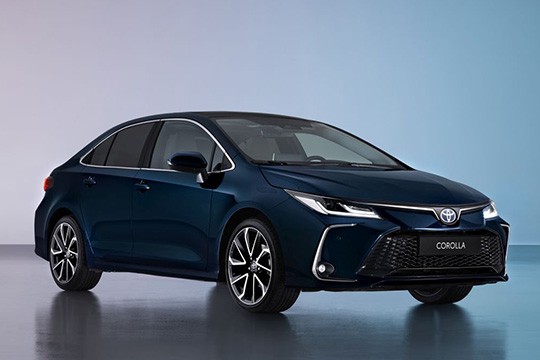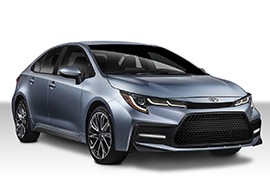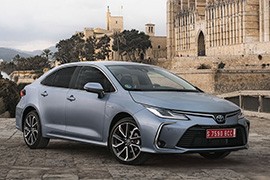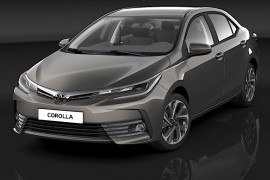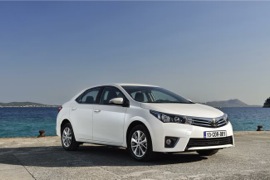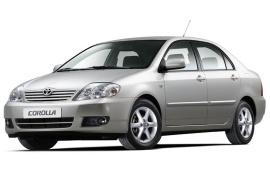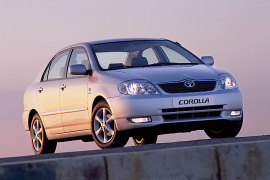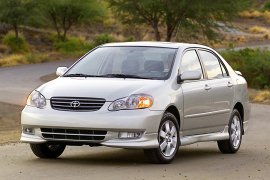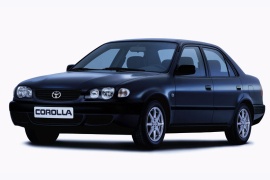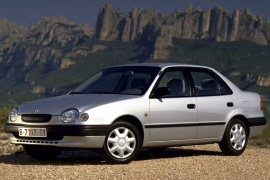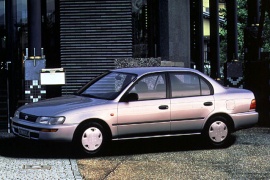TOYOTA Corolla Sedan Models/Series Timeline, Specifications & Photos
First production year: 1992
Engines: Hybrid gasoline, Gasoline, Hybrid, Diesel
Toyota refreshed the twelfth generation of the Corolla in 2022 for the European market and continued to offer it in three shapes, including the four-door sedan.
After almost six decades since the nameplate's introduction, the Corolla was the best-selling car in the world, with more than fifty-million units delivered. The automaker tried to create a car for everyone and did that better than anyone else. By producing it as a sedan, five-door hatchback, and station wagon, most people could get one to fit their needs. In 2018, Toyota introduced the twelfth generation of this nameplate. Come 2022, and the automaker launched a facelifted version of it.
While it kept a similar front fascia, with the same angry-looking headlights, these were different than the pre-facelifted version and featured bi-LED lights. Also, the bumper featured a broad grille with a trapezoidal shape in the middle. On the lower side, this was flanked by the foglamps' scoops. The sedan-shaped Corolla featured the same ascending beltline on its bodywork, with the raked-forward rear windscreen. To create a premium look for the car, Toyota kept the chromed trims around the windows.
Inside, the automaker installed new upholstery with a 3D pattern. On the dashboard, the automaker offered an option for a 10.5" touchscreen mounted in a floating position. Starting from the mid-grade level. The Corolla sedan featured a 12.3" display for the instrument panel instead of traditional dials and gauges. In the back, there was limited room for three adults due to the lower roof line, but still, it was enough for two grown-ups or three children.
Under the hood, the automaker installed a choice of two hybrid drivetrains. Both of them performed better in terms of fuel efficiency and performance than the non-facelifted version.
Toyota introduced the twelfth generation of the Corolla in 2018 at the Geneva Motor Show, but it postponed the launch of the new model for the U.S. market until 2019 for the 2020 model year.
By the time the car went on sale on the North American continent, the Corolla was the best-selling nameplate for a passenger vehicle. Its success was primarily based on its proverbial reliability and features. Even though it never won a design contest and sometimes it looked dull, it was that mundane vehicle that kept going back and forth to work, holidays, college, or just doing school runs. But the twelfth generation spiced things up a little.
The 2020 Corolla was no longer a bland-looking vehicle. At the front, it looked wider, with aggressive, boomerang-shaped headlights. Moreover, the lower bumper featured a broad trapezoidal grille flanked by air intakes that diverted the airflow around the bodywork. The car's profile showed a cabin moved rearward, with a short deck behind the rear windscreen.
Toyota created a nicer interior on the 2020 Corolla, with an analog instrument panel where the speedometer took center stage. Atop the center stack, the automaker placed the touchscreen for the infotainment system in a free-floating way. Thus, it could raise the center console and put the gear stick in an elevated position. Yet, the flat seats at the front and the bench seat for three in the back were far from being called "sporty."
Customers could choose one of the three powertrains available: one hybrid and two gasoline-only versions. While the former was provided exclusively with an eCVT transmission, the latter ones were also available with a six-speed manual apart from a CVT gearbox.
Being the 12th generation sometimes is good, especially when your name is Corolla and you are the best selling car in the world if we don't take into account Ford F-series, which is a pickup-truck. The Corolla is now quieter, safer and cleaner than before. It even ditches the diesel engines! The Japanese also ditched the Auris badge for the hatchback.
They say to not judge a book by its cover. It is the same with the Corolla. From the outside, some might say it is a nice facelift but actually it is a completely new car based on the Toyota New Global Architecture (TNGA) GA-C. The 2019 Corolla range has a new sportier look, and it is equipped with a new infotainment system that allows Android Auto and Apple CarPlay.
Thanks to the new platform, the new Corolla has four-wheel independent suspension and a different mounting for the front McPherson type to improve road-holding. As an option, the Corolla Touring Sports and Corolla Hatchback may be equipped with an electronically controlled adaptive suspension.
The engines offered are a 1.2-liter turbo with 114 HP for the hatchback and Touring Sports and a 1.6-liter naturally aspirated 132 HP gasoline engine for the sedan. True to its words of commitments on the ecology side, Toyota offers two choices of hybrid technologies: a 1.8-liter with 122 HP and a new 2.0-liter with 180 HP.
Introduced in 1968, the Corolla succeeded in being one of the best-selling cars in the Toyota lineup. In 2016, it received a facelift for its eleventh generation.
With dozens of millions of cars sold worldwide, the Corolla was a huge success for the Japanese carmaker. But instead of selling it as a singular model, Toyota adapted it depending on the market. For the European version, for instance, it offered it with better handling than on the U.S. market, where it installed softer dampers. The engines also varied, some of them being produced exclusively for the Old Continent's customers.
Along with the facelifted version, the Corolla received a much more aggressive front fascia, with swept-back headlights and an A-shaped lower apron flanked by fake air-intakes that hosted the fog lights. Depending on the options, it featured blacked-out B-pillars and windows trims.
Inside, the carmaker offered the Corolla with an eight-inch infotainment touch-screen, complemented by a secondary TFT display in the instrument cluster. Unfortunately, while the design looked like it followed the German carmakers, the materials' quality was not at the same level. Fake leather seats with cloth centers were offered for the front bucket seats, while at the back, a bench profiled for two and with hardly any room for three completed the five-seat layout.
Under the hood, Toyota installed a choice of three engines, dropping the 2.0-liter turbodiesel from the non-facelifted version.
It was the most sold passenger car in the world and, by the time its eleventh generation was launched, it counted 40 million around the world. And the 2013 version added some more.
In 2013 the Corolla was only the 3-box version, while the hatchback-sister was named Auris. The overall length of the vehicle was increased over the previous generation, but the overall height was decreased. The front fascia has received a more aggressive design, leaving the bald look of the older versions behind. The front bumper had a V-shape with one central air-intake and two side air-scoops, where the fog lights are included. Toyota claimed that the design team learned a few tricks from the Toyota F1 team in order to reduce the drag coefficient. The overall aspect was sporty, a characteristic unknown by the older Corollas.
The compact vehicle featured an all-new interior design and its main advantage over the previous generation was the wheelbase increase with 100 mm (3.9") up to 2700 mm (106.3") resulting in more legroom for the rear passengers. The 2013 Corolla featured a minimalist design of the dashboard, topped by a soft upper surface. For the infotainment system, Toyota installed on upper trim levels the Toyota Touch 2 and Toyota Touch 2 with Go navigation system. The touch-screen display was easy to reach and read by the driver.
Toyota introduced the ninth generation of the Corolla in 2000, and four years later, it came with a refresh for the entire lineup, including the Sedan version.
The Corolla nameplate was already known worldwide, and the Japanese carmaker tried to offer as many as it could produce. Besides the hatchback version, Toyota offered a sedan compact model that was more suitable for those who didn't consider sharing the same space with the trunk.
Despite the car's technical qualities, the Corolla sedan suffered from the same bland design as its siblings. The upgraded version tried to create a better image with the introduction of the smoked taillights. But the front fascia was almost the same, albeit the clear-lens headlights with a more angular design looked a tad more aggressive than on the 2002 model year. Moreover, the lower part of the bumper featured a revised grille with a horizontal slat flanked on the sides by the optional round foglamps instead of the previously used horizontal ones.
Inside, the carmaker installed a better-designed interior. The Corolla featured an infotainment unit fitted with a monochrome LCD depending on the trim levels. Moreover, the climate control unit was upgraded with new push buttons for the upper trim levels instead of turning knobs. Yet, the flat bucket seats at the front provided a mere bolstering, not enough to encourage the driver to drive the car fast on a winding road.
Under the hood, Toyota offered a choice of four engines, with two gasoline and two turbo-diesel units. In addition, a four-speed automatic was available for specific powerplants.
Toyota introduced the ninth generation of the Corolla in Europe in 2002, and it tried to be the same decent car with decent running costs as before.
The Corolla was one of the best-selling cars in the world. The Japanese carmaker proved the vehicle's reliability, which helped the sales, despite its bland styling or hard plastic materials.
They say to not judge a book by its covers and the Corolla was a fine example of that. Its headlights had nothing special in their styling. A black grille adorned at the top with a chromed slat, and the manufacturer's badge was the only bright spot of the front fascia. Its straight, horizontal lines from the bumper showed no dynamism whatsoever. But the bland design went further from its profile, where the Sedan version showed that sometimes the designers should go out from their offices seeking some inspiration.
Inside, Toyota installed hard plastic materials on the door panels and dashboard for all three trim levels. The base model, Earth, featured a simple air-conditioning system, front power windows, mirrors, and locks. The middle trim level, Luna (moon), provided power windows for the rear passengers and a better sound system. For the full-options version, named Sun, the carmaker, installed leather upholstery, steering wheel, and gear-stick. All versions were good to carry four adults, with a smaller, narrower place for a child in the middle of the rear bench.
Under the hood, Toyota offered a choice of two gasoline and one turbo-diesel engine. For the 110 hp, 1.6-liter unit, the carmaker provided an option for a four-speed automatic gearbox.
Toyota introduced the ninth generation of the Corolla in Japan in 2000, but it took the carmakers two years to bring it in the U.S.
The Corolla was already the best-selling nameplate among passenger cars in the world. Its key-elements were simplicity and reliability. It was a very user-friendly vehicle. The 2002 Corolla tried to get rid of the older jokes regarding its performances, and the Toyota's designers managed to give the car a better look.
The 2002 Corolla was not that bland anymore. Its angled headlights with clear lenses and the sportier-looking front bumper made it compete better with other Japanese carmakers. The carmaker offered the Corolla with side-skirts and a small wing on the trunk lid on the upper trim levels. While it didn't look as sporty as it tried, it looked sportier than the rest of its siblings.
Inside, a three-spoke steering wheel and some wood-trims on the dash made the Corolla looks a little bit upmarket, even though it wasn't. The curved lines and the taller center console divided the front area into two. The carmaker installed white dials inside the instrument cluster for the sport trim-level and replaced the wood-trims with black plastic.
Under the hood, Toyota installed a new engine with a variable valve timing system that brought more power to the 1.8-liter four-pot. While the base version provided 135 hp from a non-VVTi unit, the top of the range featured a 164 hp mill to bring more joy for the driver.
Toyota refreshed the fifth generation of the Corolla in 2000, five years after the model's introduction, and offered it in a few body shapes, including the popular three-box sedan.
As one of the best-selling vehicles in the world, the automaker had to meet its customers' expectations. This facelift was so significant that many people considered it as being a new generation, even though it wasn't.
One of the most essential upgrades was that the entire Corolla range got the same front fascia design, thus making it easier not only for the automaker to build but also for customers to recognize it. Toyota introduced a double headlamps system for the entire range, including the sedan. That led to a redesigned grille with horizontal slats and a new wrapped-around plastic bumper that sported a lower grille and a pair of side scoops. The car's greenhouse was ended into a raked-forward rear windscreen right above the rear wheels.
Inside, the designers changed the dashboard completely. They installed a small LCD on top of the center stack and buttons around it. It was used for the audio system as an ancestor for the infotainment systems. The instrument panel was different, depending on the engine option, with or without a tachometer. Finally, the rear bench was suitable for up to three passengers on short trips but not that good on long travels.
Under the hood, Toyota installed a small range of engines consisting of a 1.6-liter gasoline unit and two diesel versions: a 1.9-liter carried over from Peugeot-Citroen, and a 2.0-liter turbo-diesel developed in-house.
Already famous for their great reliability and excellent value for money, the Corolla range was updated in 1997.
Guiding their evolution process on the “If it’s not broken, don’t fix it” idea, Toyota managed to keep Corolla’s position on the market, thus it was awarded the world’s best selling car title in 1997.
The 5-door sedan was upgraded along with the 5-door liftback, the estate and the saloon body styles.
A world car, the Toyota Corolla was sold in three different markets: Japan, North America and Europe.
While the previous models were greatly appreciated, Toyota noticed the customer’s need of a more fun-to-drive vehicle, thus excitement needed to be a word to define the new generation.
The new models came with a changed suspension, new fabrics inside, more lively design elements and a heavily redesigned exterior look, with revised headlights, a new grille and new taillights. The redesigned exterior also helped reducing the NVH levels with its flush-mounted side windows and other techniques borrowed from Lexus.
Other changes included new technical specifications and well as more equipment.
Both gasoline and diesel units were available, however, the Japanese market had a broader range of engines to choose from. Most Corollas were powered by a 1.8-liter all-aluminium DOHC 4-cylinder engine that developed 120 hp and 122 pound-feet of torque. Besides more power offered, the engine helped achieving a lower fuel consumption than its predecessor.
Concerned about safety, Toyota offered the Corolla with four-wheel antilock brakes and side-impact airbags.
The seventh generation of the best-selling Toyota ever came on the market in 1991 in various shapes and sizes, from a sporty-looking coupe to a family-oriented station wagon. The sedan, though, could not be missed by the Japanese carmaker.
Toyota made an important step in Corolla's evolution when it introduced the E100 model. It focused more on safety and fuel efficiency than before. Moreover, it made it handle better due to the increased wheelbase and track over the E90.
With its three-box design, the sedan featured a slim front fascia that enhanced the aerodynamics. Unfortunately, it came on the market just before the biodesign revolution. It was somehow stuck between the boxy design from the '80s and the waved, curved design of the mid-'90s. Nevertheless, its flush door handles and the curved C-pillars helped the car achieve a 0.30 drag coefficient.
Inside, the carmaker placed low-mounted bucket seats at the front, divided by a short center console. The new center stack featured the vents at the top, followed by the radio and the HVAC controls on the lower side. With its curved dashboard and minimalist design, the Corolla was the kind of car that didn't excel in its look, but it wasn't ugly either. For the base versions, the carmaker didn't even bother to install a tachometer. In the back, the bench was wide enough for two adults or three children. Out back, the trunk could handle up to 419 liters (14.8 cu. ft.), which was enough for a family.
Under the hood, Toyota installed a wide engine choice, depending on the market. The base version featured a sluggish 1.3-liter powerplant. Unfortunately, the top-of-the-range 2.0-liter naturally aspirated version was available only for the Japanese market. Moreover, Europeans could take the 2.0-liter diesel that provided an outstanding fuel efficiency.
